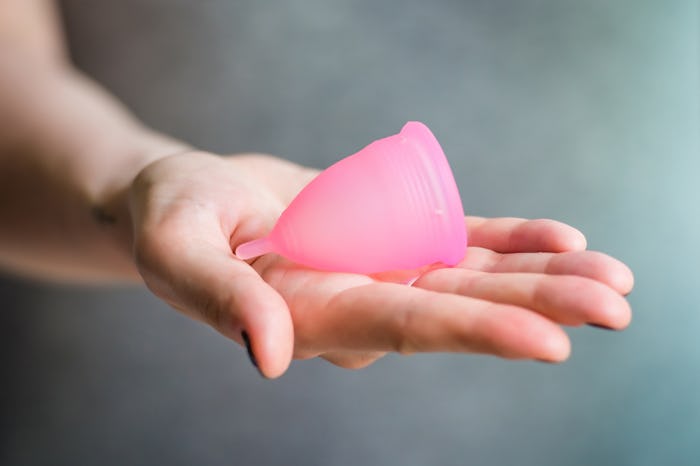Life

Wait, You Can Go How Long Without Changing A Menstrual Cup? Sold
I was obnoxious when I first "discovered" the genius of the menstrual cup, and I took every opportunity to share my love for my little silicone period saver with all my girlfriends. Eventually, my best friend told me I sounded like I was part of a multi-level marketing menstrual cup scheme, and I decided to cool it... but I stand by my endorsement. While I love their financial benefits and packing ease, the thing that originally got my attention was how often menstrual cups need to be changed. What is the appropriate changing schedule, and what do the experts say?
Rated by Business Insider as the best menstrual cup currently on the market, the DivaCup is a popular choice for menstrual cup users. The FAQ section on the DivaCup website makes it easy to find their wear instructions: "The DivaCup can be worn up to a maximum of ten (10) – twelve (12) consecutive hours and should be emptied, washed and rinsed a minimum of two (2) – three (3) times daily," states the website. Considering the recommended wear time for a standard tampon is four to six hours, or eight hours max, according to Women's Health, the menstrual cup emerges as a clear winner in terms of convenience.
That said, every woman's flow is different. Kim Rosas, one of the authors behind the informative menstrual cup website Put A Cup In It, has advice for menstrual cup newbies. "...You will want to remove your cup after 3-4 hours the first day you try it. You will see how much is in the cup and based on that visual, you’ll be able to gauge if you could have left it in much longer or if it was way overdue." As you continue to wear your menstrual cup, you'll learn more about your flow and how long you can realistically wait to change your cup before it's full (or close to it).
A big reason that wearers can go so long between menstrual cup changes is thanks to how much blood the cup can hold. "A menstrual cup can hold 1 ounce of liquid, roughly twice the amount of a super-absorbent tampon or pad," explained WebMD. In other words, when your tampon or pad may be starting to leak, your menstrual cup is only about half full.
Additionally, menstrual cups help "maintain the natural environment of the vaginal canal" because they simply collect menstrual flow and vaginal fluid as opposed to absorbing them, explains Carinne Chambers-Saini, CEO of Diva International Inc., to Romper. It's still crucial to stick to that 10 to 12 hour timeframe between cleaning, of course, but when you've got a busy schedule, these extra hours can make all the difference.
A few skeptics I've spoken to have had similar responses when I've shared this 12-hour factoid with them. Sure, you have to change it less, but when you do change it, isn't it a whole messy to-do? I'll be straight with you... it can be, at first. When you first began using tampons, you likely took more time putting them in and taking them out, and the same is true with menstrual cups. Practice makes perfect! "With your forefinger and thumb, gently pull on the stem until you can reach the base of the cup. Pinch the base of the cup. This will break the seal," Chambers-Saini explains to Romper. "Gently move the cup from side to side and pull down to fully remove the cup. Once it is out, empty the contents into the toilet and wash the cup at your sink with warm water and mild, unscented, oil-free soap." The more you use your menstrual cup, the faster and easier this process will become
Menstrual cups, just like any other feminine hygiene product, don't work for everyone. That said, their benefits are numerous if they do indeed work for you. They'll help save you cash, help save the planet, and, as busy women just might care about most, save a whole lot of time.
Edit note: This article has been updated from a previous version to clarify Carinne Chambers-Saini's quote: The DivaCup does not make any claims to minimizing the risk of TSS.